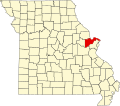St. Charles County | |
|---|---|
 St. Charles County Courthouse in St. Charles | |
 Location within the U.S. state of Missouri | |
 Missouri's location within the U.S. | |
| Coordinates: 38°45′36″N90°37′00″W / 38.76°N 90.6167°W | |
| Country | |
| State | |
| Founded | October 1, 1812 |
| Named after | Charles Borromeo |
| Seat | St. Charles |
| Largest city | O'Fallon |
| Government | |
| • County executive | Steve Ehlmann (R) |
| Area | |
• Total | 593 sq mi (1,540 km2) |
| • Land | 560 sq mi (1,500 km2) |
| • Water | 32 sq mi (83 km2) 5.4% |
| Population (2020) | |
• Total | 405,262 |
| • Density | 720/sq mi (280/km2) |
| Time zone | UTC−6 (Central) |
| • Summer (DST) | UTC−5 (CDT) |
| Congressional districts | 2nd, 3rd |
| Website | www |
St. Charles County is located in the central eastern part of the U.S. state of Missouri. As of the 2020 census, the population was 405,262, [1] making it Missouri's third-most populous county. Its county seat is St. Charles. [2] The county was organized October 1, 1812, and named for Saint Charles Borromeo, an Italian cardinal.
Contents
- History
- Geography
- Adjacent counties
- Major highways
- National protected area
- Climate
- Demographics
- 2020 census
- Education
- Public schools
- Private schools
- Alternative schools
- Higher education
- Public libraries
- Government
- Law enforcement
- Library resolution
- Politics
- Local
- State
- Federal
- Federal politics
- Communities
- Cities
- Villages
- Census-designated place
- Other unincorporated places
- Islands
- Subregions
- Westplex
- See also
- References
- External links
St. Charles County is part of the St. Louis, MO-IL Metropolitan Statistical Area and contains many of the city's northwestern suburbs. The wealthiest county in Missouri, [3] St. Charles County is one of the nation's fastest-growing counties.
St. Charles County includes a part of the Augusta AVA, an area of vineyards and wineries designated by the federal government in 1980 as the first American Viticultural Area. [4] The county's rural outer edge along the south-facing bluffs above the Missouri River, is also part of the broader Missouri Rhineland.



